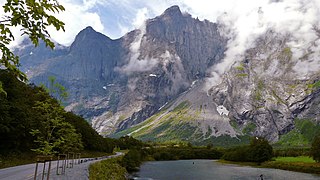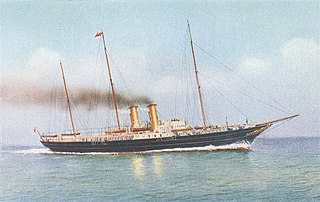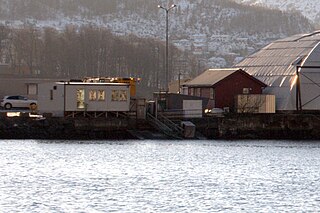
Transport in Norway is highly influenced by Norway's low population density, narrow shape and long coastline. Norway has old water transport traditions, but road, rail and air transport have increased in importance during the 20th century. Due to the low population density, public transport is somewhat less built out in rural areas of Norway, however public transport in, and around cities is well developed.

Tourism in Denmark is a growing industry and a major economic contributor: tourists spent a total of DKK 128 billion and the tourism industry employed 161,999 people in full time positions in 2017.

Nordland is a county in Norway in the Northern Norway region, the least populous of all 11 counties, bordering Troms og Finnmark in the north, Trøndelag in the south, Norrbotten County in Sweden to the east, Västerbotten County to the south-east, and the Atlantic Ocean to the west. The county was formerly known as Nordlandene amt. The county administration is in the town of Bodø. The remote Arctic island of Jan Mayen has been administered from Nordland since 1995. In the southern part of the county is Vega, listed on the UNESCO World Heritage Site list.

Stranda is a municipality in Møre og Romsdal county, Norway. It is part of the Sunnmøre region. The administrative centre of the municipality is the village of Stranda. Stranda consists of three smaller villages and one larger central village. The smaller villages are Hellesylt, Geiranger, and Liabygda. The central village, Stranda, has about 2,600 inhabitants. Stranda Municipality is known for tourist attractions like the Geirangerfjorden Sunnylvsfjorden and its skiarea at Strandafjellet

Drøbak is a town and the centre of the municipality of Frogn, in Viken county, Norway. The city is located along the Oslofjord, and has 13,409 inhabitants.

The Norwegian railway system comprises 4,109 km of 1,435 mm track of which 2,644 km is electrified and 274 km double track. There are 697 tunnels and 2,760 bridges.

The Rauma Line is a 114.2 kilometres (71.0 mi) long railway between the town of Åndalsnes, and the village of Dombås, in Norway. Running down the Romsdalen valley, the line opened between 1921 and 1924 as a branch of the Dovre Line, which connects to the cities of Oslo and Trondheim. Originally intended as the first stage to connect Ålesund, and possibly also Molde and Kristiansund, no extensions have ever been realized. The unelectrified line is served four times daily with SJ Norge's Class 93, although in the summer the service only operates from Åndalsnes to Bjorli as a tourist service. CargoLink operates a daily freight train.

Valdres is a traditional district in central, southern Norway, situated between the districts of Gudbrandsdalen and Hallingdal. The region of Valdres consists of the six municipalities of Nord-Aurdal, Sør-Aurdal, Øystre Slidre, Vestre Slidre, Vang and Etnedal. Valdres has about 18,000 inhabitants and is known for its excellent trout fishing and the local dialect. Its main road is E16 and Fylkesveg 51.

Romsdalen is a valley in the western part of Norway. The 60-kilometre (37 mi) long valley runs through Rauma Municipality in Møre og Romsdal county and Lesja Municipality in Innlandet county. It is the valley of the Rauma river, from Old Norse word Raumsdalr which means Rauma valley. The traditional district of Romsdal, which makes up about one-third of Møre og Romsdal county, is named for the valley of Romsdalen. The main road E136 and the Rauma line runs along the valley floor.

Flåm is a village in the Flåmsdalen valley which is located at the inner end of the Aurlandsfjorden, a branch of Sognefjorden. The village is located in Aurland Municipality in Vestland county, Norway. In 2014 its inhabitants numbered 350.

Nordfjordeid is the administrative centre of the municipality of Stad in Vestland county, western Norway. It is located at the end of the Eidsfjorden, an arm of the main Nordfjorden, west of the large lake Hornindalsvatnet. The village of Stårheim is located about 12 kilometres (7.5 mi) to the west, the village of Mogrenda is about 5 kilometres (3.1 mi) to the east, and the village of Lote is about 7 kilometres (4.3 mi) to the southeast.

HMY Alexandra was a steamship built as a British royal yacht, completed in 1908. Normally transporting Britain's royal family to European ports, Alexandra served as a hospital ship during the First World War. After 17 years of British service, she was sold to Norwegian commercial interests in 1925. Renamed Prins Olav, she was first used as a luxury cruise ship on trips to the North Cape, she was converted to take more passengers and cargo. In 1937 she began sailing as a Hurtigruten passenger/cargo ship along the coast of Norway. After being requisitioned by the Norwegian government following the 9 April 1940 German invasion of Norway, she transported troops for the Norwegian war effort. Prins Olav was sunk by German bombers on 9 June 1940, while attempting to escape to the United Kingdom as the Norwegian Campaign was coming to an end.
Norsk Air was a Norwegian airline based at Sandefjord Airport, Torp. At its height from the mid-1980s and onwards it operated scheduled flights to Stavanger, Bergen, Trondheim and Copenhagen, and for shorter periods also other Norwegian and international destinations. The airline had 156 employees and 150,000 annual passengers in 1989. The company was established as a sole proprietorship by Øyvind Skaunfelt as Vestfoldfly in 1961, after purchasing Thor Solberg's aviation school at Tønsberg Airport, Jarlsberg. In addition to an aviation college, the company operated various charter services using mostly Cessna aircraft. The company split into a flying school and an airline in 1972, with the latter taking the name Norsk Flytjeneste. Three 50-passenger Douglas DC-6 were subsequently bought and were among other places flown with aid charters to Bangladesh. Both the DC-6 and later charter flights with business jets proved unprofitable and were quickly terminated.
Fjellfly was a Norwegian airline which operated between 1954 and 1972. The airline was based at Skien Airport, Geiteryggen and served a diverse range of general aviation activities and a limited scheduled services. Major undertakings included distribution of the newspaper Dagbladet, flying tourists into mountainous areas such as Hardangervidda and crop dusted forest areas. A scheduled service was introduced from Skien to Oslo Airport, Fornebu in 1963, and was extended to Sandefjord Airport, Torp and Hamar Airport, Stafsberg four years later. At its peak in 1965, the airline had a fleet of fourteen aircraft.

Trondheim Central Station or Trondheim S is the main railway station serving the city of Trondheim, Norway. Located at Brattøra in the north part of the city centre, it is the terminus of the Dovre Line, running southwards, and the Nordland Line, which runs north. The railway is electrified south of the station but not north of it, so through trains must change locomotives at the station.

Opened on the 8th of October 1998, the only high-speed rail in Norway, on the railways of Norway is on Gardermobanen, a 64 kilometer line between Oslo Central Station and Eidsvoll via Oslo Airport. The main service on this route is Flytoget, commuting between Oslo Airport and the metropolitan areas of Oslo at speeds of up to 210 km/h (130 mph). It was extended westwards to include the city of Drammen in 2008, though not at high speed. The high-speed section is also used by express and regional trains between Oslo and Eidsvoll.

The Church of Jesus Christ of Latter-day Saints in Norway is a restorationist free church. There are more than 4,500 members in Norway. A temple to be built in Oslo was announced on April 4, 2021 by church President Russell M. Nelson.

Bergen Airport, Sandviken is a water airport and heliport situated in the Sandviken neighborhood of Bergen, Norway. The aerodrome is located on the artificial peninsula of Kristiansholm. It is currently serving seaplanes and helicopters operated by Fonnafly aimed at air taxi services at cruise ship tourists. The airport is owned by Bergen Municipality through Bergen Port Authority and is part of the Bergen Port. Operations are carried out by Fonnafly.

The Norwegian Fjordhorse Center is the national resource center of the Fjord Horse breed in Norway. The center was established in 1989 and is owned by the Norwegian Fjord Horse Association, Stad Municipality and the Vestland County authority. The main goal of the center is to promote the breeding and usage of the horses.
























